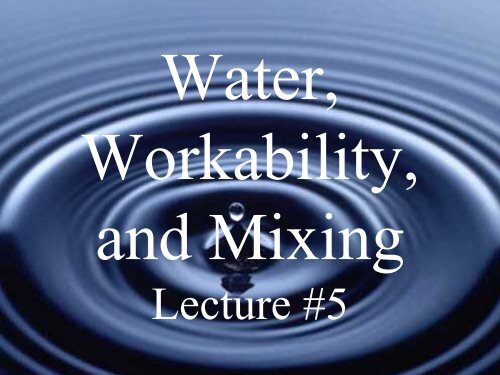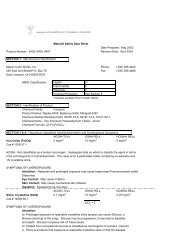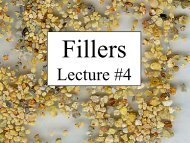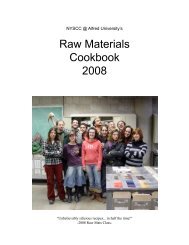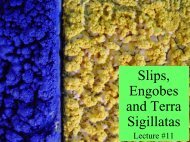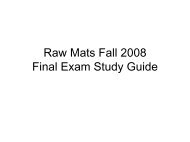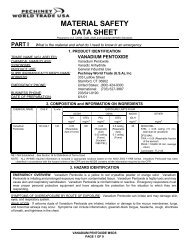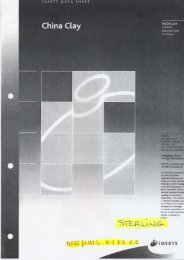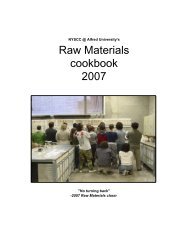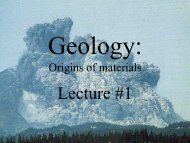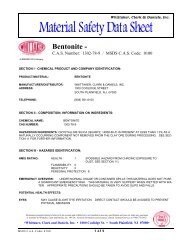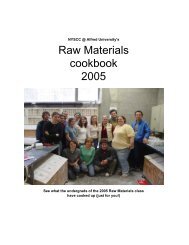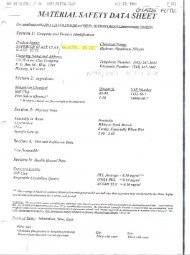Lecture #5 - Alfred's Clay Store - Alfred University
Lecture #5 - Alfred's Clay Store - Alfred University
Lecture #5 - Alfred's Clay Store - Alfred University
- No tags were found...
Create successful ePaper yourself
Turn your PDF publications into a flip-book with our unique Google optimized e-Paper software.
Water,Workability,and Mixing<strong>Lecture</strong> <strong>#5</strong>
• Water is a raw material• Water has a physical size and a chemicalcharge, just like all other materials we use• Its chemical/physical nature affects a claybody’s working properties– Plasticity– Drying– Firing
Types of Water
Water of Plasticity• The excess water between surfacesof kaolinite particles• What we are most familiar with– We add this when we add water to ourdry powdered clay• A.K.A. Lubricant water / Free water• Acts like a suspension system– Water completely surrounds each clayparticle– Promotes lubrication between clayparticles• Is completely removed during drying
Water of Plasticity For <strong>Clay</strong>s• Varies widely between clay types based on surface area• Fine grained clays may require up to 40%• Coarse grained clays - as low as 15%% Water of Plasticity37 OM-4 Ball <strong>Clay</strong>30 XX Sagger Stoneware26.2 Tile 6 Kaolin15 Hawthorn Bond Fireclay• These numbers do not tell us how plastic a clay will be;they simply tell us how much water they need to achievetheir respective optimum plasticity
Water of Plasticity Test• Determines theamount of waterrequired to developoptimum plasticity• Water is added to dryclay until plasticity(not stickiness) isreached• C.C. of water used =water of plasticity %
Pore Water• Occupies the pores of a claybody after water of plasticitydries off• Remains after shrinkage iscomplete and clay particles arein contact with each other• In bone dry clay, pore watercontent reflects atmospherichumidity– Amount changes as humidity inthe air changes• Remains until about 250°F
Chemically Bound Water(crystal-edge water and water of constitution)• Is only removed around red heat 1112° F(022-021)– 842° F Starts to leave clay– 1292° F Completely removed• Once removed, cannot be replaced– Kaolinite crystal collapses– <strong>Clay</strong> becomes “calcined”– Plasticity is lost– This is sometimes referred to as “the ceramicchange”
Crystal-Edge Water• Water that isbonded to thecharge deficiencyof kaolinite’sedgesCrystal Edge Water
Water of ConstitutionAlPart of the kaolinite structureAl 2 O 3 • 2SiO 2 • 2H 2 OSiWater (OH) bonds Si and Allayers-Overcomes chargedeficiencies between Siand Al•Makes up to 13.95%of the weight of bonedry clay in a perfectkaolin sample
PlasticityHaving looked at the structure ofwater and its three main types, wewill now examine plasticity
Plasticity• Definition: A material’s ability to be formedunder pressure without rupturing, and withoutreturning to its original form• Plasticity is a function of two properties– Shear• The force required to cause deformation– Extension• The amount of deformation possible before cracking
Initial ResistanceMovementbeforecrackingCracking
less plasticweakermore plasticstronger• For a given extension,coarse clays must slidefurther past each otherthan fine clays• In fine clay, extension isshared by more particles(particles are not hyperextendedas they are incoarse clay)
Plastic Flow in a Typical BodyShear (force)Extension (movement)A = Yield pointB = Maximum extension--- = crackingChronology1- Shear increasesuntil the yield pointis reached2- Beyond yieldpoint, extensionincreases with littleadditional shear3-Beyond maximumextension, crackingoccurs
Plastic Vs. Non-PlasticShear (force)Extension (movement)• Quartz– No yield point; verylittle extension,regardless of forceapplied• Ball <strong>Clay</strong>– Past the yield point,extension increaseswith little additionalforce
Particle Size• Smaller particle size = more contact points• Contact points allow for more cohesion /lubrication
Plasticity in clays increases with reduction in particle sizeBentonitesPlasticityBall <strong>Clay</strong>sBall <strong>Clay</strong>sKaolinsKaolinsFireclaysWater, in percent of dry clay• Note increase in water content (water of plasticity) required as particlesdecrease in size
• QuantifyingPlasticity• Bentonites (most plastic)• Ball <strong>Clay</strong>s• Stonewares• Earthenwares• Kaolins• Fireclays• Shales (least plastic)Generalizations can bemisleading… take thiswith several m 2 /g of salt
Workability• Often used interchangeably with plasticitythough they are not the same thing• Workability - Combines plasticity and strength• Very important for throwing and other formingtechniques during which slumping is aproblem• Not as crucial for press molding or leather hardconstruction
Flocculation• A <strong>Clay</strong> particle exhibits both attractive andrepulsive forces in the presence of other clayparticles• A Flocculated clay mixture is one in which theattraction between clay particles overcomesthe repulsion• Flocculation improves cohesion/contact amongclay particles
A flock of clay• Flocculation makes the clay’s edgespredominately positive or negative• Sides then become attracted to theopposite charge on nearby clay surfaces
Flocculation• <strong>Clay</strong>s are usually slightly flocculated in theirnatural state• We can increase flocculation to improve cohesion(strength) by adding flocculants– Ball clays and Bentonites (and coarser clays to a lesserdegree)– Vinegar (temporarily effective), Magnesium Sulphate(MgSO 4 •7H 2 O; a.k.a. Epson salts {caveat…scumming}), Calcium Chloride (CaCl 2 ), etc…– Possibilities for research…especially in porcelainbodies???
• Deflocculation involves increasing therepulsion between particles• Decreases viscosity/destroys plasticity• We will look at deflocculation when wediscuss slips
Particle Shape<strong>Clay</strong>• Flatness of clay particles– Surface tension in water allows suction to develop betweenparticles– Allows particles to slide past each other (like wet plates ofglass)• Granular particles lack these qualities (regardless oftheir size)
Particle Size Distribution• Bodies that rely too much on fine clays don’thave enough resistance (i.e. their yield point istoo low), and due to their large surface area (andlarge water content) tend to shrink a lot• However, too much coarse materials allow waterto easily permeate the body, weakening thestructure (loosing shape during forming)• A wide distribution of particle sizes (large,medium and small) helps increase the body’sinterlocking qualities– increases strength (holds shape better)
Diversity in particle size ensures greater contact between particlesI.E. Kaolin clayNarrower Particle RangeLess contact between particlesLess strengthLess workabilityI.E. Stoneware clayWider Particle RangeMore contact between particlesMore strengthMore workability
Particle Distribution• Narrower range ofdistribution• Largerconcentration ofparticles in themiddle%100 %finer than0 %Coarse Medium Fine10 (microns) 5 1 .2100 %• Wider range ofdistribution%• Slope is morefiner thanconstant whichsuggests a more evenrange of particles 0 %from large to small 10 (microns) 5 1 .2
Narrow rangeWide range
70 microns = 200 mesh< means smaller than > means greater than
CPFT = Cumulative Percent Finer Than
• So workability is affected by– Plasticity• Shear/Extension• Particle size• Water of plasticity (lubrication)– Strength• Flocculation• Particle shape• Particle distribution• Various other factors can enhance workability in abody– Moisture retention– Souring / Aging– Processing
Moisture Content• As we’ve already seen, each clay has itsown water of plasticity (optimum moisturecontent)• Above and below this range, workability iscompromised– Not enough water = not enough lubrication– Too much water = Yield point is too low (nostrength/closer to a liquid than a plastic)
Moisture Retention• Moisture retention describes how slowly orquickly a clay dries• Particle size determines moisture retention• Fireclays or other clays with coarserparticles tend to have lower moistureretention (and a narrower working range)• Ball clays and other fine clays haveincreased moisture retention (thus a widerworking range)
Moisture Retention• Fine clays hold more water than coarserclays– Greater surface area in fine clays than in coarseclays• Finer clays also dry slower (smallerparticles tend to clog air passages)– working time is extended over coarser clays
Souring• Souring – A bacteriological process• Organic content in clay decomposes overtime (months/years), forming bacteria• Bacteria produces (poops) amino acids• Acids flocculate fine clay particles (increasingparticle bonding)• Given enough time, flocculation penetrates down tocolloidal sized particles
Souring• Secondary clays tend to contain moreorganic impurities than pure kaolins– Higher strength in many secondary clays is duein part to souring of plant matter (added duringsedimentation)• Soured moist clay is added to acceleratebacterial growth in new batches• Organics are often added to a clay beforemixing– Yogurt, milk, beer etc…– Be aware that souring smells bad; possiblehealth effects?
Aging• A clay body stored in its plastic state will improvein workability over time• Water permeates clay slowly– Time allows moisture to even itself out in the body– Kaolinite stacks delaminate into smaller particles• Believed to cause a slight compression over time,which brings particles closer together• Effects are often noticeable after just one week ofstorage• If clay is dried, the effects of aging are lost
Mixing• Homogenous mixtures are crucial in producing areliable material– Predictable forming, drying, & firing require ahomogenous mixture• Take a 1 cubic inch sample from the next batch ofclay you mix and ask yourself…“Does it reflect the batch’s entire recipe?”
• Shearing during mixingbreaks down lumps– increases surface area ofclay body– allows water to coat allsurfaces evenly• Pockets of unmixedfeldspar or flint willpresent problems duringfiring– (slumping/cristobalite…more on this later)
Relative scale of materials in a clay body
Relative surface areas of materials• Grog ??? n/a (off the chart)• Flint 1.4 m²/g• Feldspar 1.5 m²/g• <strong>Clay</strong> 15.0 m²/g• Bentonite 31.7 m²/g• Veegum 100.0 m²/g• Larger numbers indicate smaller particlesizes
Given what we now know aboutrelative surface areas…• Homogeneity is crucial• <strong>Clay</strong> particles should coat all otheringredients– There is enough clay in any recipe to coat all nonplasticsand still have plenty left-over• We can promote this through the order inwhich we add our materials during mixing
Mixing ChronologyFor Soldner Mixers1-Start with finest materials (clays)– They need the most water to wet their hugesurface area– When using bentonite or Veegum, blunge thisinto the batch’s full amount of water first usingthe Shar mixer2-Add fluxes and flint3-Add large fillers (Grog) last
Soldner Mixer• The safest clay-mixer wehave• Very inefficient– Almost no shearing action– Very little energy goes intomixing• Mixture remainsheterogeneous– Clumps of clay, flux andfillers remain largelyuntouched
Muller-mixerThe Muller creates high shearing forces-Much higher energy than Soldner mixers
Mixing ChronologyFor the Muller• Order of materials is irrelevant, as everythingwill be dry mixed before water is added– That’s partly why the Muller is such a greatsystem– However, separately blunging Bentonite orVeegum in water is still required
Yield point decreases• Increase in temperature decreases surface tension in water(lowers the yield point of clay)– Keep temperature in mind when deciding if consistency of clay inthe Muller-mixer is right (the Muller heats up the clay over time;warm clay gets stiffer when it cools to room temperature)
Blunging• Ensures complete/homogenous mixing• <strong>Clay</strong> body is mixed in an excess of water– All particles are thoroughly wetted– Particles are able to move everywhere• Stacks of clay are physically torn apart– Exposes more surface area (allows for more extension)• Virtually all industrial applications rely on blunging(I.e. commercial dinnerware, computer chipmanufacturing etc.)• Electrical insulators are required to blunge by law toensure proper mixing
The Shar Blunger• The best clay mixer.PERIOD.• High intensity mixingchews up agglomeratesof material• Runs @ 3600 rpm (mostdrills run @ 1750 rpm)• Ideal for preparing finermaterials like bentonite,along with complete claybodies• Can also be used toreclaim scrap
• High speed shear head(cuts like a knife)• Low shear/high flow• Can’t be run fast due toangle of blades• Ideal for dispersingliquids in liquids, not forshearing clay
Mixing chronologyfor blunging (Shar Mixer)1-Start with the flint and fluxes + roughly ¼ ofthe total clay content– Even with this small amount, there is enough clayto coat all flint and flux particles which is whatwe want– Not adding all the clay keeps the mixture morefluid, allowing for more efficient mixing2-Add the rest of the clay after a few minutes ofmixing3-Add large fillers (Grog) last
Regular MixingHigh Intensity Mixing(Shar mixer)• High intensity mixing shears agglomerates intofiner individual particles (increases plasticity)
Effect of mixing on slumping during firingEirich (dry)3.6 cmMix-Muller (dry)2.7 cmLow-intensity (slurry)1.7 cmHigh-intensity (slurry)1.5 cm
• Pumps (pushes)slip into porousenvelopes• Pushes outwater• Converts slipinto a plasticbody in a fewhoursFilter Press
HersHis
Pugging• Pugging helps break down any lumps due topoor mixing• Helps homogenize the plastic mass• Ideal when blunging has not taken place(Esp. important when using Soldner mixers)• Most pugmills de-air– Reduce air pockets– Bring particles closer together (increasesworkability)
Pugmill Stages•Running clay through a pugmill develops the sameworkability as aging clay for several weeks (because ofcompression)
The shredder stage• Air pockets are exposed to a vacuum…
ReferencesCeramics: Industrial Processing and Testingby J.T. Jones M.F. BerardIowa State <strong>University</strong> Press, Ames, IowaSecond Edition 1993Ceramic Science for the PotterW. G. LawrenceChilton Book Company, Radnor, PhiladelphiaSecond Edition, 1982<strong>Clay</strong>-Water SystemsW.G. Lawrence<strong>Alfred</strong> <strong>University</strong>1965Fine Ceramics: Technology and Applicationsby F.H. NortonRobert E. Krieger Publishing Company, Malabar, Florida1978
ReferencesThe Chemistry and Physics of <strong>Clay</strong>sby <strong>Alfred</strong> B. Searle and Rex W. GrimshawInterscience Publishers, Inc., New YorkThird Edition, 1959The Potter’s Dictionary of Materials and Techniquesby Frank and Janet HamerA&C Black Publishers Ltd., London, EnglandThird Edition, 1993Understanding Earthby Frank Press and Raymond SieverW.H. Freeman and Company, New York, NYThird Edition, 2001


